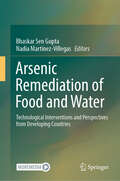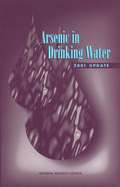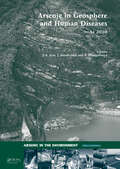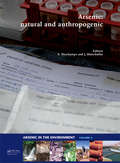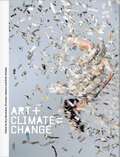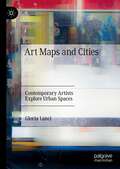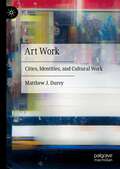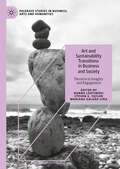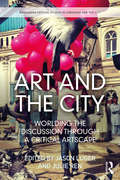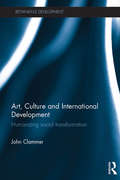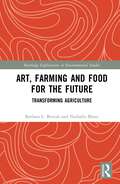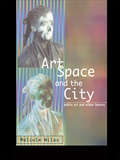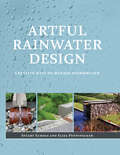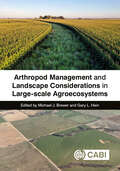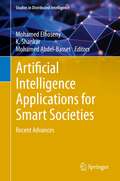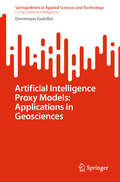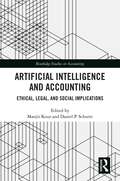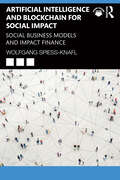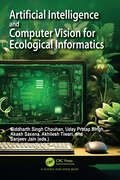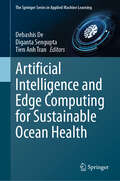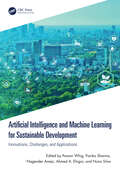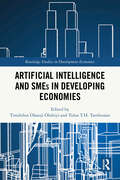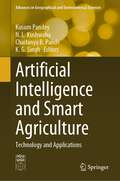- Table View
- List View
Arsenic & Rice
by Andrew A. Meharg Fang-Jie ZhaoRice is the staple food for half of the world's population. Consumption of rice is the major exposure route globally to the class one, non-threshold carcinogen inorganic arsenic. This book explains the sources of arsenic to paddy soils and the biogeochemical processes and plant physiological attributes of paddy soil-rice ecosystems that lead to high concentrations of arsenic in rice grain. It presents the global pattern of arsenic concentration and speciation in rice, discusses human exposures to inorganic arsenic from rice and the resulting health risks. It also highlights particular populations that have the highest rice consumptions, which include Southern and South East Asians, weaning babies, gluten intolerance sufferers and those consuming rice milk. The book also presents the information of arsenic concentration and speciation in other major crops and outlines approaches for lowering arsenic in rice grain and in the human diet through agronomic management.
Arsenic Remediation of Food and Water: Technological Interventions and Perspectives from Developing Countries
by Bhaskar Sen Gupta Nadia Martínez-VillegasThe book provides information on the sources of arsenic contamination of groundwater and their impacts in the first part of the book consisting of 8 chapters. Process developments such as nano-adsorbents for removal of arsenic and other heavy metals are discussed in the second part of the book that comprises of 4 chapters. The third part of the book includes 4 chapters on technological interventions for the removal of arsenic such as indigenous ceramic membranes and Subterranean Arsenic Removal (SAR). The fourth part of the book deals with arsenic contamination in food materials and food chain systems, and consists of 5 chapters. Arsenic has long been associated with a variety of health complications in the human body. In order to address this, a chapter on arsenic contamination and impacts on human health has been included in the fifth part of the book. The book would be a valuable reference material for the scientific community in developing countries working on community water supply and treatment, food safety, public health and policy.
Arsenic in Drinking Water
by Subcommittee on Arsenic in Drinking WaterThe U.S. Environmental Protection Agency (EPA) has been considering a more stringent regulation of arsenic in water. A significant reduction in the maximum contaminant level (MCL) could increase compliance costs for water utilities. This book discusses the adequacy of the current EPA MCL for protecting human health in the context of stated EPA policy and provides an unbiased scientific basis for deriving the arsenic standard for drinking water and surface water.Arsenic in Drinking Water evaluates epidemiological data on the carcinogenic and noncarcinogenic health effects of arsenic exposure of Taiwanese populations and compares those effects with the effects of arsenic exposure demonstrated in other countries—including the United States.The book also reviews data on toxicokinetics, metabolism, and mechanism and mode of action of arsenic to ascertain how these data could assist in assessing human health risks from arsenic exposures. This volume recommends specific changes to improve the toxicity analyses and risk characterization. The implications of the changes for EPA’s current MCL for arsenic are also described.
Arsenic in Drinking Water
by Subcommittee to Update the 1999 Arsenic in Drinking Water ReportHaving safe drinking water is important to all Americans. The Environmental Protection Agency's decision in the summer of 2001 to delay implementing a new, more stringent standard for the maximum allowable level for arsenic in drinking water generated a great deal of criticism and controversy. Ultimately at issue were newer data on arsenic beyond those that had been examined in a 1999 National Research Council report. EPA asked the National Research Council for an evaluation of the new data available.The committee's analyses and conclusions are presented in Arsenic in Drinking Water: 2001 Update. New epidemiological studies are critically evaluated, as are new experimental data that provide information on how and at what level arsenic in drinking water can lead to cancer. The report's findings are consistent with those of the 1999 report that found high risks of cancer at the previous federal standard of 50 parts per billion. In fact, the new report concludes that men and women who consume water containing 3 parts per billion of arsenic daily have about a 1 in 1,000 increased risk of developing bladder or lung cancer during their lifetime.
Arsenic in Geosphere and Human Diseases; Arsenic 2010: Proceedings of the Third International Congress on Arsenic in the Environment (As-2010) (Arsenic in the Environment - Proceedings)
by Jochen Bundschuh Prosun Bhattacharya Jiin-Shuh JeanThe congress "Arsenic in the Environment" offers an international, multi- and interdisciplinary discussion platform for arsenic research aimed at short-term solutions of problems with considerable social impact, rather than only focusing on cutting edge and breakthrough research in physical, chemical, toxicological, medical and other specific issue
Arsenic: Natural and Anthropogenic (Arsenic in the environment)
by Jörg Matschullat Eleonora DeschampsThe discussion on arsenic in the environment is complex and must grasp the importance of very many, mostly unrelated works on individual aspects. This volume represents one of the first comprehensive and interdisciplinary examinations into arsenic's behaviour in air, water, soils, sediments, plants and the human body. Based on state-of-the-art investigations into the global arsenic cycle, the related human toxicology and available remediation technologies, arsenic is assessed holistically in all the environmental compartments. Using the results of primary research, the authors offer concrete suggestions for risk reduction and management of environmental pollution that allow the reader to successfully tackle similar problems and find sustainable solutions.
Art + Climate = Change
by Guy Abrahams Kelly Gellatly Bronwyn JohnsonIn a period of profound environmental and social upheaval, climate change has become one of our greatest challenges. Yet for many of us, fear, confusion and frustration mean we are reluctant to consider, let alone act on this pressing issue.Rational engagement with science is vital to forming solutions to this challenge. But a cultural shift is also needed. Artists have the capacity to develop a narrative that recognises the reality of our present and inspires a vibrant, positive vision of our future.Presenting the work of Australian and international artists across twenty-nine exhibitions and events, ART+CLIMATE=CHANGE explores the power of art to create the empathy, emotional engagement and cultural understanding needed to motivate meaningful change.
Art Maps and Cities: Contemporary Artists Explore Urban Spaces
by Gloria LanciThis book presents an original study on how contemporary artists are exploring urban spaces through mapping. Despite a long history of representations of cities in maps, and the relationships that can be envisaged between art maps and cities in the contemporary world, little research is dedicated to investigating how artists intervene in the realm of urban cartography. The research examines a century-old history of art maps and draws on academic debates challenging traditional notions of maps as scientific artefacts produced through accurate measurement and surveying. The potential of art maps to construct personal narratives, through contestation, embodiment and play, is analysed in the city context, where spaces are shaped by urban planning and design, political ideologies and socio-economic forces. Adopting an exploratory and interpretative research approach that investigates the confluence of theories originated in different domains, this book conducts the reader to discover what artistic practices can bring into a more creative, while inquisitive, understanding of cities. A series of semi-structured interviews with visual artists, enquiring how they apprehend, process and re-create urban spaces in artworks, explores cartographic process and methods in visual art practices in the twenty first century, which incorporates digital technologies and critical thinking.
Art Work: Cities, Identities, and Cultural Work
by Matthew J. DureyThis book is about the relationship between art and work in the cultural economy. It is an exploration of the experiences of people working in cultural and creative industries, and of the importance of place, identity, and culture in postindustrial society. Drawing on fieldwork exploring the conditions of cultural work, identity, and postindustrial cities in Newcastle upon Tyne, UK and Hamburg, Germany, the book argues that the conditions of work in the cultural economy are the result of a contradictory tension between art and economy, which manifests in various ways in artists’ conditions of work, their identities, and their relationship to the changing landscapes of postindustrial cities. This is explored through a series of stories from people working in cultural and creative industries, in which they highlight significant contradictions, obstacles, and opportunities in negotiating the cultural economy, casting light on the importance of art and culture in postindustrial society.
Art and Sustainability Transitions in Business and Society: Theoretical Insights and Engagement (Palgrave Studies in Business, Arts and Humanities)
by Steven S. Taylor Hanna Lehtimäki Mariana Galvão LyraAn increased understanding of art and art-based-methods is needed to address the behavioral and cultural change in the sustainability transition. This edited collection explores ways to engage people in their citizen, consumer, employer, employee and entrepreneurial roles, as they grapple with the sustainability transition. It introduces art and arts-based methods to advance sustainability thinking. As a unique contribution to sustainability research, this book presents insights from artists, art organizations and specialists using arts-based-methods in education, organizational innovation and citizen engagement. The book will provide inspiring insights to scholars and students of sustainability, innovation, corporate strategy, and creativity in business.
Art and the City: Worlding the Discussion through a Critical Artscape (Routledge Critical Studies in Urbanism and the City)
by Jason Luger Julie RenArtistic practices have long been disturbing the relationships between art and space. They have challenged the boundaries of performer/spectator, of public/private, introduced intervention and installation, ephemerality and performance, and constantly sought out new modes of distressing expectations about what is construed as art. But when we expand the world in which we look at art, how does this change our understanding of critical artistic practice? This book presents a global perspective on the relationship between art and the city. International and leading scholars and artists themselves present critical theory and practice of contemporary art as a politicised force. It extends thinking on contemporary arts practices in the urban and political context of protest and social resilience and offers the prism of a ‘critical artscape’ in which to view the urgent interaction of arts and the urban politic. The global appeal of the book is established through the general topic as well as the specific chapters, which are geographically, socially, politically and professionally varied. Contributing authors come from many different institutional and anti-institutional perspectives from across the world. This will be valuable reading for those interested in cultural geography, urban geography and urban culture, as well as contemporary art theorists, practitioners and policymakers.
Art, Culture and International Development: Humanizing social transformation (Rethinking Development)
by John ClammerCulture is not simply an explanation of last resort, but is itself a rich, multifaceted and contested concept and set of practices that needs to be expanded, appreciated and applied in fresh ways if it is to be both valued in itself and to be of use in practical development. This innovative book places culture, specifically in the form of the arts, back at the centre of debates in development studies by introducing new ways of conceptualizing art in relation to development. The book shows how the arts and development are related in very practical ways – as means to achieve development goals through visual, dramatic, filmic and craft-inspired ways. It advocates not so much culture and development, but rather for the development of culture. Without a cultural content to economic and social transformation the problems found in much development – up-rooting of cultures, loss of art forms, languages and modes of expression and performance – may only accelerate. Paying attention to the development of the arts as the content of development helps to amend this culturally destructive process. Finally, the book argues for the value of the arts in attaining sustainable cultures, promoting poverty alleviation, encouraging self-empowerment, stimulating creativity and the social imagination, which in turn flow back into wider processes of social transformation. Discussion questions at the end of each chapter make this book ideal to help foster further thinking and debate. This book is an inspiring read for postgraduate students and researchers in the fields of development studies, cultural studies and sociology of development.
Art, Farming and Food for the Future: Transforming Agriculture (Routledge Explorations in Environmental Studies)
by Nathalie Blanc Barbara L. BenishThis book explores the impact of artistic experiments in inspiring people to turn away from current food consumerism and take an active role in preserving, sustaining, and protecting the environment. As artists are expanding their practice into social justice and community concerns, erasing traditional forms of expression and integrating others, the culture around food and its production has been added to a new vocabulary of experiential art. The authors measure the impact of such experiments on local food consumption and production, focusing on education and youth, both in the surrounding community and culture at large. They suggest how these projects can be up-scaled to further encourage sustainable solutions for our environment and communities. The book explores the reflections and motivations of case study practitioners in urban and rural areas and, through interviews, engages with artists who are pioneering a new trend to create hubs of activity away from traditional art spaces in cities to follow a non-hierarchal practice that is de-centralized and communally based. This book will be of great interest to academic readers concerned with issues related to environmental aesthetics, eco-design, eco-criticism, culture, heritage, memory, and identity, and those interested in the current debates on the place of aesthetics and culture in sustainability.
Art, Space and the City
by Malcolm MilesPublic art - the making, management and mediation of art outside its conventional location in museums and galleries, and the livable city - a concept involving user-centred strategies for urban planning and design, are both socially produced but have emerged from different fields and tend to be discussed in isolation.This book applies a range of critical perspectives which have emerged from different disciplines - art criticism, urban design, urban sociology, geography and critical theory - to examine the practice of art for urban public spaces, seeing public art from positions outside those of the art world to ask how it might contribute to possible urban futures. Exploring the diversity of urban politics, the functions of public space and its relation to the structures of power, the roles of professionals and users in the construction of the city, the gendering of space and the ways in which space and citizen are represented, the book explains how these issues are as relevant to architecture, urban design and urban planning as they are to public art. Drawing on a wealth of images from across the UK and Europe and the USA, in particular, the author questions the effectiveness of public art in achieving more convivial urban environments, whilst retaining the idea that imagining possible futures is as much part of a democratic society as using public space.
Artful Rainwater Design: Connecting Theory, Practice, And Possibilities
by Stuart Echols Eliza PennypackerStormwater management as art? Absolutely. Rain is a resource that should be valued and celebrated, not merely treated as an urban design problem--and yet, traditional stormwater treatment methods often range from ugly to forgettable. Artful Rainwater Design shows that it's possible to effectively manage runoff while also creating inviting, attractive landscapes. This beautifully illustrated, comprehensive guide explains how to design creative, yet practical, landscapes that treat on-site stormwater management as an opportunity to enhance site design. Artful Rainwater Design has three main parts: first, the book outlines five amenity-focused goals that might be highlighted in a project: education, recreation, safety, public relations, and aesthetic appeal. Next, it focuses on techniques for ecologically sustainable stormwater management that complement the amenity goals. Finally, it features diverse case studies that show how designers around the country are implementing principles of artful rainwater design. Artful Rainwater Design is a must-have resource for landscape architects, urban designers, civil engineers, and architects who won't let stormwater regulations cramp their style, and who understand that for a design to truly be sustainable, people must appreciate and love it. It is a tool for creating landscapes that celebrate rain for the life-giving resource it is--and contribute to more sustainable, healthy, and even fun, built environments.
Arthropod Management and Landscape Considerations in Large-Scale Agroecosystems
by Matthew O'Neal Steven E. Naranjo Ian MacRae Kristopher L Giles Tom Royer Peter C Ellsworth Kristen Baum Mahendra Bhandari Haley Butler Hannalene Du Plessis Norman C. Elliott Sarah Elzay Isaac L. Esquivel Ashleigh M. Faris Aaron J. Gassmann Maura Hall Louis S. Hesler Anders S. Huseth William D. Hutchison Robert L. Meagher Jr Lance J. Meinke Shannon L. Osborne Pankaj Pal Katherine A. Parys Dominic Reisig Nina Rudin Thomas W. Sappington Gregory A. Sword Ashley E. Tessnow Paul A. Umina Johnnie Van BergFor large-scale agroecosystems, patterns of pest population increases (graded increases or abrupt outbreaks) and declines (graded suppression or abrupt crashes) vary considerably and are influenced by factors within crop fields and across broader landscape scales. Better understanding of pest population dynamics and the implications of spatial interactions on the function and development of pest management approaches are the main themes of this important book. The book builds from a 60+ year history of field-based pest management by focusing on the drivers of pest management in large-scale agroecosystems and the landscape-scale processes that affect these drivers and contribute to variation in pest outbreaks and suppression. These drivers include abiotic and biotic influences such as weather, spatial composition and arrangement of landscape elements, and widely applied managed inputs such as planting and crop rotation schedules, crop varietal selection, and land and soil conservation efforts. The book introduces general concepts, opportunities, and challenges of arthropod management in large-scale agroecosystems. Case studies from major field crop-based agroecosystems are used to present research approaches and improve understanding and management of pest and beneficial insects in large-scale agroecosystems. Specific research findings are provided on multi-trophic interactions within the system as influenced by climate, landscape, and other ecological, agricultural, and social/economic components of the agroecosystem. The book concludes with a synthesis of these concepts and prospectus for future research and developments in arthropod management in large-scale, plant-based agroecosystems. The book is essential reading for researchers in applied entomology and ecology and for pest management practitioners.
Artificial Intelligence Applications for Smart Societies: Recent Advances (Studies in Distributed Intelligence)
by Mohamed Elhoseny K. Shankar Mohamed Abdel-BassetThis volume discusses recent advances in Artificial Intelligence (AI) applications in smart, internet-connected societies, highlighting three key focus areas. The first focus is on intelligent sensing applications. This section details the integration of Wireless Sensing Networks (WSN) and the use of intelligent platforms for WSN applications in urban infrastructures, and discusses AI techniques on hardware and software systems such as machine learning, pattern recognition, expert systems, neural networks, genetic algorithms, and intelligent control in transportation and communications systems. The second focus is on AI-based Internet of Things (IoT) systems, which addresses applications in traffic management, medical health, smart homes and energy. Readers will also learn about how AI can extract useful information from Big Data in IoT systems. The third focus is on crowdsourcing (CS) and computing for smart cities. this section discusses how CS via GPS devices, GIS tools, traffic cameras, smart cards, smart phones and road deceleration devices enables citizens to collect and share data to make cities smart, and how these data can be applied to address urban issues including pollution, traffic congestion, public safety and increased energy consumption. This book will of interest to academics, researchers and students studying AI, cloud computing, IoT and crowdsourcing in urban applications.
Artificial Intelligence Proxy Models: Applications in Geosciences (SpringerBriefs in Applied Sciences and Technology)
by Dominique GuérillotThis Springer Brief focuses on the use of artificial intelligence (AI) in geosciences and reservoir engineering. This concise yet comprehensive work explores how AI-driven proxy models can effectively tackle the computational challenges associated with reservoir simulations, history matching, production optimization, and uncertainty analysis. In reservoir engineering, a key challenge is reproducing observed production and pressure data using forward simulation models, known as reservoir simulators. However, the inverse problem of history matching requires running hundreds of simulations, each demanding significant computational resources. Full-scale reservoir simulators are often too time-consuming, making proxy models—such as second-order polynomials, kriging, and artificial neural networks (ANN)—essential alternatives. This Springer Brief emphasizes the power of AI, particularly ANN, as the most pragmatic approach for addressing real-world reservoir engineering problems. ANN has already gained widespread acceptance in computationally intensive fields such as aerospace, defense, and security due to its ability to model nonlinearities. Given the highly nonlinear nature of reservoir simulations, this book demonstrates how artificial neural networks-based proxies provide efficient and accurate solutions. To illustrate these concepts, the methodology is applied to a synthetic field inspired by real-world data: the Brugge field dataset. This widely used open-source dataset enables practitioners to familiarize themselves with AI-driven workflows in reservoir simulation. The Brief covers key applications, including history matching, production optimization (e.g., well placement and production rates), and uncertainty analysis, with detailed explanations of the workflows for each case. This Brief offers high-quality scientific content aligned with international research standards. It is now available in both print and digital formats.
Artificial Intelligence and Accounting: Ethical, Legal, and Social Implications (Routledge Studies in Accounting)
by Manjit Kour Daniel P. SchutteIn the dynamic field of accounting, where accuracy and productivity are critical, artificial intelligence (AI) integration has become a game-changer and AI is set to affect every industry. With the speed at which technology is developing, a thorough manual that helps readers understand the complex world of AI in accounting is desperately needed. By offering a sophisticated grasp of how AI is changing the core ideas of accounting and financial management, this book bridges this knowledge gap. It explores the relationship between AI technology and accounting processes, revealing the significant influence and unrealised potential outside of traditional bookkeeping.This book delves into how AI is revolutionising accounting procedures. It explores the newest AI technologies and their uses in financial data processing, auditing, compliance, and forecasting, ranging from machine learning to predictive analytics. It ensures responsible AI integration by addressing biases, accountability, and transparency while emphasising ethical considerations. This book provides case studies, practical advice, and examples from the real world, guaranteeing that readers not only understand the theoretical foundations of AI in accounting but also get the knowledge necessary to apply and maximise these technologies within their professional domains by connecting theory and application. It offers a road map for traversing the accounting industry's AI frontier, from using predictive analytics to make well-informed decisions to automating repetitive activities.This book will enable accountants, auditors, and financial analysts to prosper in the emerging AI-driven world.
Artificial Intelligence and Blockchain for Social Impact: Social Business Models and Impact Finance
by Wolfgang Spiess-KnaflArtificial Intelligence and Blockchain for Social Impact provides an accessible overview of artificial intelligence (AI) and blockchain technologies, and explores their applications for social enterprise and impact investing. The opening chapter introduces the impact space, exploring different social business models, the role of technology, the impact investing market and general problems in the space. The remainder of this book falls into two paths: the first focusing on AI and the other looking at the blockchain technology. Providing introductions to each of these technologies and their histories, the author goes on to examine them from the perspectives of social business models and impact finance. A concluding chapter explores AI and cryptocurrencies in the impact space in the future. Readers are supported with international case studies and other student-friendly features. Situated at the intersection between technology, fintech, social enterprise, impact investing and social impact, this book is a valuable resource for upper-level courses across all these areas. It also offers an introduction to this emerging topic for researchers and business professionals. Online teaching resources to accompany this book include instructor lecture slides and data sets.
Artificial Intelligence and Computer Vision for Ecological Informatics
by Sanjeev Jain Akhilesh Tiwari Siddharth Singh Chouhan Uday Pratap Singh Akash SaxenaEcological informatics, more commonly known as Ecoinformatics, is the study of environmental sciences and ecological information. It is an emerging interdisciplinary framework for the management, analysis, and synthesis of ecological data with the help of advanced computational intelligence algorithms. Management in this context is data acquisition, preprocessing, and sharing the data. Analysis and synthesis are the process of extracting useful information and forecasting with the help of intelligent algorithms.The aim of this book is to encapsulate concepts and theories of artificial intelligence and computer vision algorithms used for the evaluation of various ecological informatics applications. It focuses on soft computing, machine learning, deep learning, artificial intelligence, bio-inspired algorithms, data analysis tools, data visualization tools, and computer vision algorithms used in ecological informatics. The book covers remote sensing applications, water bodies evaluation, agriculture mapping, aquatic mapping, forest management, and terrestrial ecosystems.The book will be useful to students, researchers, scientists, and field experts in directing their work towards this domain, to deliver and design models and prototypes for the benefit of society and the environment.
Artificial Intelligence and Edge Computing for Sustainable Ocean Health (The Springer Series in Applied Machine Learning)
by Debashis De Tien Anh Tran Diganta SenguptaArtificial Intelligence and Edge Computing for Sustainable Ocean Health explores the transformative role of AI and edge computing in preserving and enhancing ocean health. The growing influence of Artificial Intelligence (AI), along with the Internet of Things (IoT) in generating wide coverage of sensor networks, and Edge Computing (EC) has paved the way for investigation of underwater as well as massive marine data, thereby generating huge potential for credible research opportunities for these domains. This book’s journey begins with a broad overview of Artificial Intelligence for Sustainable Ocean Health, setting the foundation for understanding AI's potential in marine conservation. The subsequent chapter, Role of Artificial Intelligence and Technologies in Improving Ocean Health in Promoting Tourism, illustrates the synergy between technological advancements and sustainable tourism practices, demonstrating how AI can enhance the attractiveness and preservation of marine destinations. The identification, restoration, and monitoring of marine resources along with the utilization of technology continues in Utilization of Underwater Wireless Sensor Network through Supervising a Random Network Environment in the Ocean Environment has been extensively dealt with. The technical challenges of underwater imaging, essential for accurate data collection and analysis has been discussed. The importance of Explainable AI is discussed in chapters like Sustainable Development Goal 14: Explainable AI (XAI) for Ocean Health, Explainable AI (XAI) for Ocean Health: Exploring the Role of Explainable AI in Enhancing Ocean Health, and A Comprehensive Study of AI (XAI) for Ocean Health Monitoring, which emphasize transparency and trust in AI systems. Further, Revolutionizing Internet of Underwater Things with Federated Learning, Underwater Drone, Underwater Imagery with AI/ML and IoT in ROV Technology and Ocean Cleanup has been demonstrated using innovative approaches to addressing underwater challenges. The book also includes a Review on the Optics and Photonics in Environmental Sustainability, focusing on the role of optics in marine conservation. Security issues are tackled in Intelligent Hash Function Based Key-Exchange Scheme for Ocean Underwater Data Transmission, and the overarching potential of AI in marine resource management is discussed in Artificial Intelligence as Key-enabler for Safeguarding the Marine Resources.
Artificial Intelligence and Machine Learning for Sustainable Development: Innovations, Challenges, and Applications
by Ahmed A. Elngar Pawan Whig Nuno Silva Nagender Aneja Pavika SharmaArtificial Intelligence and Machine Learning for Sustainable Development is a comprehensive exploration of how artificial intelligence (AI) and machine learning (ML) technologies are revolutionizing the field of sustainable development.The book examines cutting-edge innovations, practical applications, and potential challenges in harnessing AI and ML to address global sustainability issues. It offers insights into how these technologies can optimize resource management, improve environmental monitoring, enhance decision-making processes, and promote equitable, eco-friendly solutions. This book would be of special interest to researchers, policymakers, and practitioners seeking to leverage cutting-edge technology for a more sustainable future.
Artificial Intelligence and SMEs in Developing Economies (Routledge Studies in Development Economics)
by Tulus T.H. Tambunan Timilehin Olasoji OlubiyiArtificial Intelligence and SMEs in Developing Economies explores the emergence and application of Artificial Intelligence in developing economies. This is in response to the shift in Artificial Intelligence research towards the achievement of Sustainable Development Goals (SDGs), as well as the environmental problems and methods to solve them.Written by experts from around the globe from developing countries, the book contains a balance of theoretical and empirical chapters that explore Artificial Intelligence in the context of business. It focuses especially on integrating industry 5.0 where Artificial Intelligence plays a major role. The chapters include knowledge and applications for small businesses, ranging from disruptive Artificial Intelligence technologies to determinants of Artificial Intelligence adoption in SMEs from major developing economies such as Africa, Latin America and Asia. In the latter chapters, the book discusses the application of Artificial Intelligence, such as how to leverage it for sustainable and responsible small businesses, and the importance of appreciating in a business environment. This book is the first substantial study on Artificial Intelligence and the future of sustainable small businesses in emerging economies.It is a useful resource for academics and university students with interest in Artificial Intelligence and sustainable small businesses, specifically small business development. It is also a valuable read for policy makers and SME stakeholders.
Artificial Intelligence and Smart Agriculture: Technology and Applications (Advances in Geographical and Environmental Sciences)
by Chaitanya B. Pande N. L. Kushwaha Kusum Pandey K. G. SinghAs technology continues to saturate modern society, agriculture has started to adopt digital computing and data-driven innovations. This emergence of “smart” farming has led to various advancements in the field, including autonomous equipment and the collection of climate, livestock, and plant data. As connectivity and data management continue to revolutionize the farming industry, empirical research is required to understand these technological developments. This book explores the applications of various artificial intelligence techniques by identifying and describing technical, functional, and non-functional future technologies for smart farming and agriculture. The book also presents practical application opportunities for the resolution of real-world problems, including contributions from precision irrigation, greenhouse data, livestock monitoring, automation, IoT ecosystems for agriculture, cloud computing, mobile robots for precision agriculture, remote sensing applications, anddata mining. In addition, this book provides summary information about different soilless techniques such as hydroponics, aeroponics, and aquaponics, among others. This book is ideally designed for farmers, agriculturalists, product managers, farm holders, manufacturers, equipment suppliers, industrialists, governmental professionals, researchers, academicians, and students seeking current research on technological applications within agriculture and farming.

